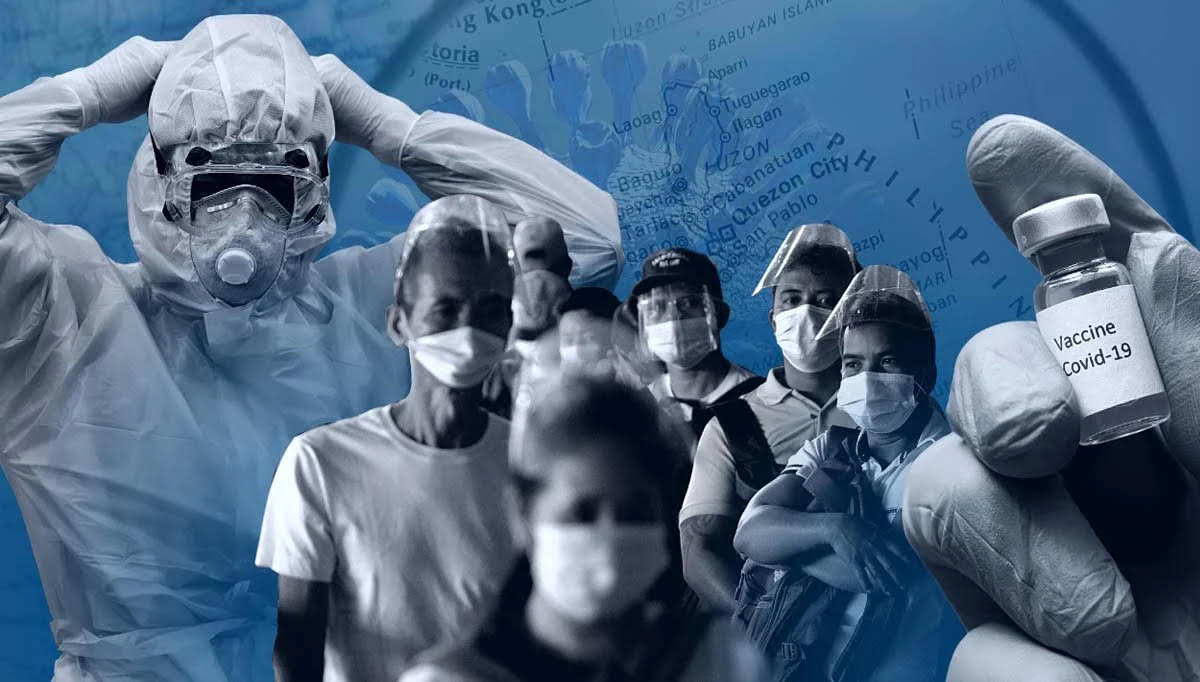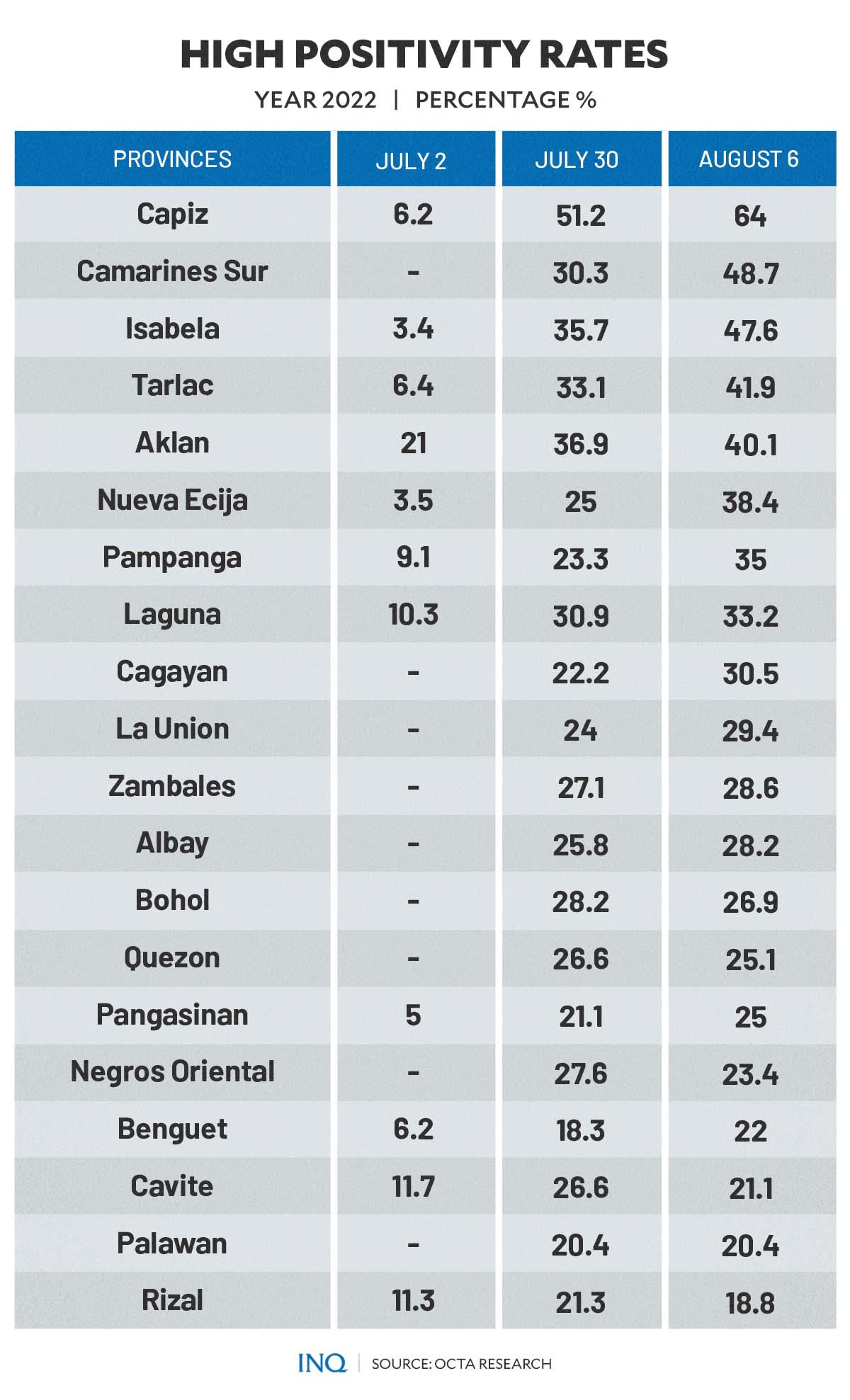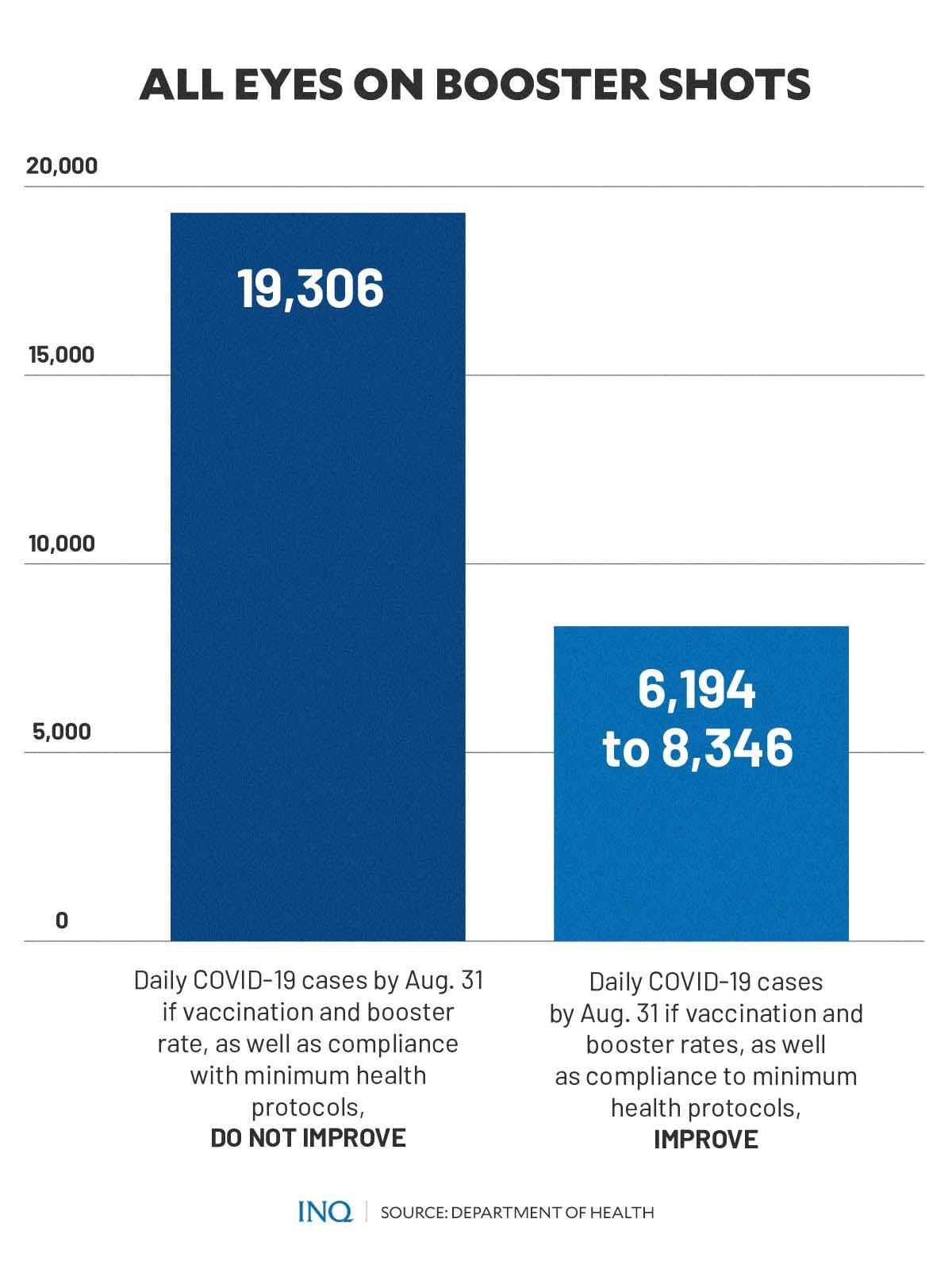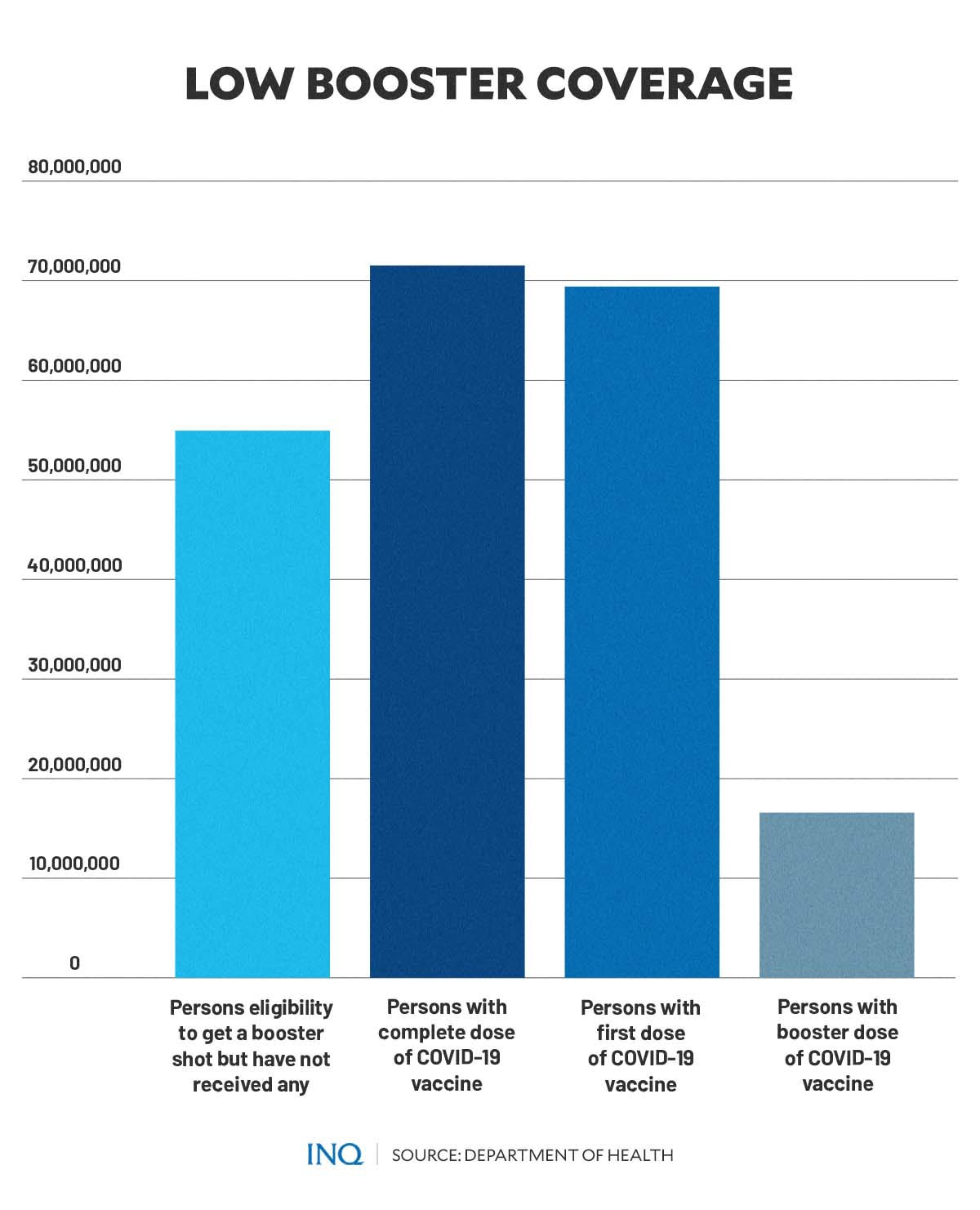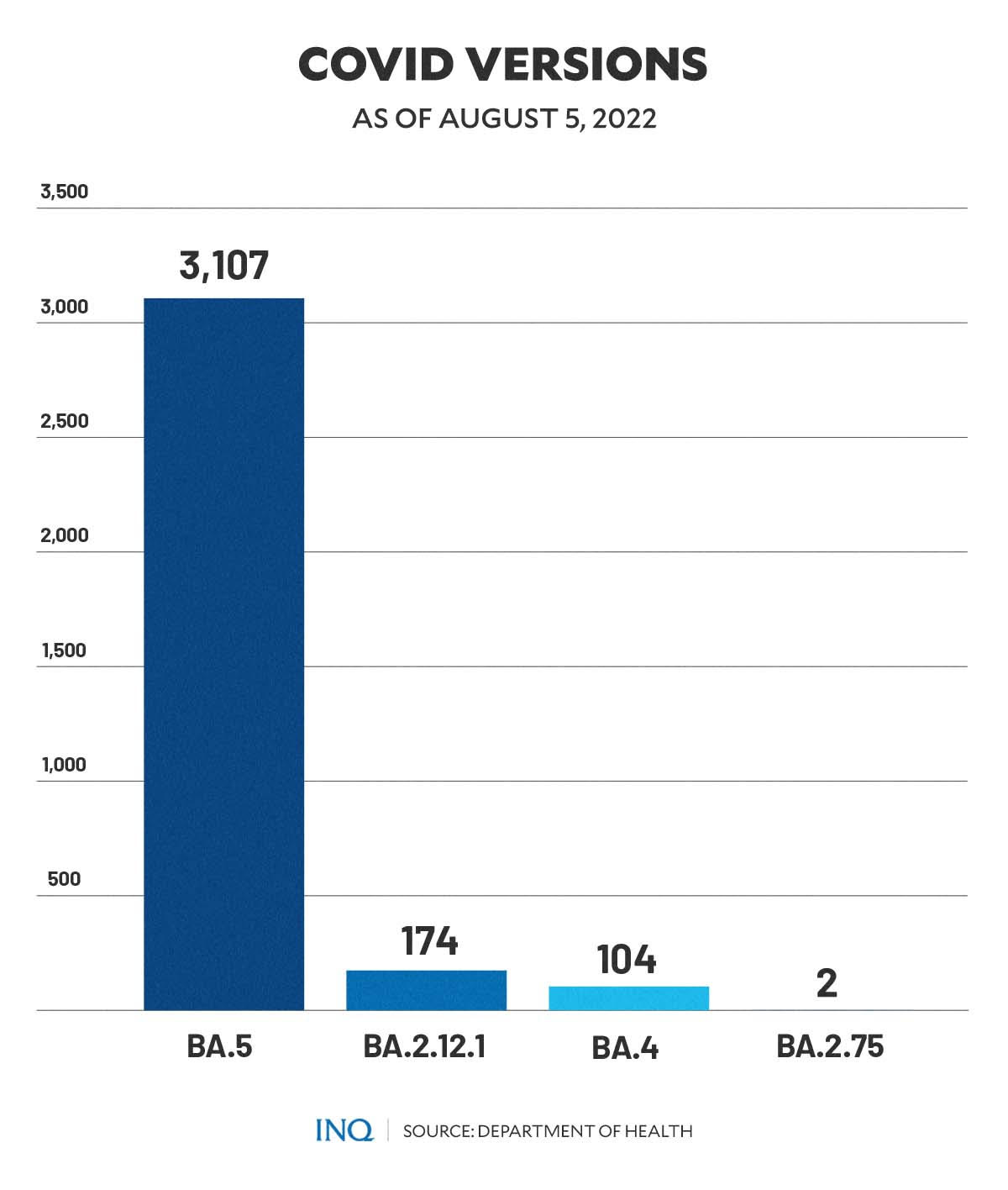Latest COVID wave: When waning immunity, expired vaccines, new strains mix
MANILA, Philippines—While Octa Research initially expected a two-month COVID-19 wave, it said on Monday (Aug. 8) that the surge is taking longer than expected.
Dr. Guido David, an Octa Research fellow, said 20 provinces—15 in Luzon and five in the Visayas—registered high positivity rates, which were above 20 percent, on Saturday (Aug. 6).
He said “very high” positivity rates were logged in Capiz (64), Camarines Sur (48.7), Isabela (47.6), Tarlac (41.9), Aklan (40.1), Nueva Ecija (38.4), Pampanga (35), and Laguna (33.2).
Positivity rates in Cagayan (30.5), La Union (29.4), Zambales (28.6), Albay (28.2), Bohol (26.9), Quezon (25.1), Pangasinan (25), Negros Oriental (23.4), Benguet (22), Cavite (21.1), Palawan (20.4), and Rizal (18.8) were also deemed concerning.
David said he expected a two-month wave because of the Omicron sub-variants BA.4 and BA.5: “We’ve already had two months (June to August) but we’re not yet at the peak, so it’s taking longer.”
Article continues after this advertisementThe Department of Health (DOH) said 4,203 new cases were recorded on Monday (Aug. 8), higher than the 3,904 average daily cases from Aug. 1 to Aug. 7.
Article continues after this advertisementAn additional 2,618 new infections were logged on Tuesday (Aug. 9). While it decreased the number of active cases to 36,666, the new cases only reflect the tests conducted on Sunday (Aug. 7) at only 14,122, which is significantly lower than the average—usually above 20,000.
The department’s COVID-19 Tracker showed that the new cases raised the country’s total caseload to 3,810,772, with 3,713,242 recoveries and 60,864 deaths. Currently, the average national positivity rate is 18.6 percent, almost two percent higher than the previous week’s 16.7 percent.
READ: National COVID positivity rate jumps to 18.6 percent –DOH
Prolonged wave
Presenting OCTA Research’s projections, David said at a public briefing that “right now, it’s looking like it will last up to four or five months, well, into the ‘ber’ (September, October, November, December) months.”
READ: COVID-19 wave may reach ‘ber’ months
Last July 26, the DOH warned that daily cases may reach as high as 19,306 by Aug. 31 if vaccination and booster rates, as well as compliance with minimum health protocols, do not improve.
READ: Low vaccination, booster turnout may lead to over 19,000 daily COVID cases by August — DOH
Based on DOH data, 71,523,190 persons have already received complete COVID-19 vaccine doses, but only 16,587,595 persons have been administered booster shots—54,935,595 persons eligible for booster have not yet received any shot.
The department stressed that if vaccination and booster rates, as well as compliance with minimum health protocols improve, daily cases will reach only 6,194 to 8,346 by Aug. 31.
The government reiterated the need to continue wearing best-fitting face masks, isolating when sick, doubling-up protection through vaccines, and ensuring good airflow to control the spread of SARS-CoV-2, the virus that causes COVID-19.
This, as the DOH told CNN Philippines last month that the “wall of immunity [against COVID-19] is really going down,” stressing that hospitalizations could possibly rise by August and September.
Vaccine effectiveness
David stressed that one of the reasons for the COVID-19 wave is the waning immunity of people who have been administered with the vaccines and the public’s lack of compliance with minimum health protocols.
Based on a study, which was published in The Lancet, vaccine effectiveness wanes five months after the second dose—Pfizer-BioNTech (82.1 percent); AstraZeneca (75.7 percent); and Moderna (75.7 percent).
Entitled “COVID-19 Vaccine Waning and Effectiveness and Side-Effects of Boosters,” the study said vaccine efficacy decreased more in people who are 55 years or older and in people with comorbidity.
“After five months, vaccine effectiveness remained high among individuals younger than 55 years. Booster doses restore vaccine effectiveness. Adverse reactions after booster doses were similar to those after the second dose,” it said.
David said OCTA Research is not yet recommending the escalation of COVID-19 Alert Levels because of low hospitalization, stressing that “we can endure it (rising cases) for now.”
“This is the reason why [the government] embarked on a vaccination and booster drive so that our hospital utilization rate will not increase and for our economy and our businesses to remain open,” he said.
Based on DOH data, 27,331 new cases were logged from Aug. 1 to Aug. 7. Out of this, 76 were severe and critical cases, while 24.8 percent of COVID-19 intensive care unit beds are occupied, slightly higher than the 23.3 percent last week.
Wasted vaccines
As the DOH said that the “wall of immunity is really going down,” it stressed the need for Filipinos to get booster shots, saying that there are a lot of reasons for COVID-19 cases to rise.
The problem, however, is that there is a looming wastage of up to P13.5 billion worth of unused and expired COVID vaccines while the number of infections continued to reach record-highs.
RELATED STORY: 3.6 million COVID-19 vax doses now expired; 632,000 doses to expire soon — Concepcion
Last Aug. 3, Sen. Risa Hontiveros filed a resolution seeking to investigate why 4 million to 27 million vaccine doses, worth an average of P500 each, were bound to be thrown away.
She acknowledged that vaccine doses would be unusable for various reasons and the figure would be tainted with a margin of error.
“But in this case, should we just say goodbye to billion peso-worth of vaccines? We cannot brag that we have outdone Asyong Aksaya [because] someone has to answer for all these,” she said.
RELATED STORY: A waste of resources looms: 1.6-M COVID vaccines to expire in August — Concepcion
“It is reprehensible that billions of pesos could end up squandered amid the continuing threat of COVID-19 and the need to fund the needs of the other sectors heavily affected by the pandemic,” Senate Resolution No. 92 stated.
Hontiveros asked: “Were there shortcomings in the processes, and if so, where did these take place? Was it in the purchase? The rollout? The issuance of guidelines? The bottom line is that money and supplies went to waste regardless of whom these came from.”
For Dr. Tony Leachon, there was a need for a “new plan of action” in responding to COVID-19 and vaccination as a new “more transmissible and evasive” Omicron sub-variant threatened the country.
COVID strains
David said he was not ruling out the possibility that the “prolonged” wave is caused by the possible spread of the BA.2.75 sub-variant, which “appears to more easily bypass the defenses built up against SARS-CoV-2 through small, specific changes.”
Last month, the World Health Organization stressed that while it was closely monitoring the new version of Omicron, which has already been detected in over 10 countries, “there are still limited sequences available to analyze.”
Octa Research said “it’s possible that our wave is getting prolonged because of, maybe, the effects of BA.2.75 that is causing additional infections—this is just a possibility.”
It was on Aug. 2 when the DOH detected the country’s first two cases of the BA.2.75 sub-variant. Both cases were from Western Visayas and were already tagged as recovered.
READ: Unending mutation of the COVID virus brings a new creature: BA.2.75
Dr. Cynthia Saloma, executive director of the Philippine Genome Center, said since then, the center has so far not found any BA.2.75 in the random COVID-19 samples it had tested.
She then went on to say that the BA.5 sub-variant, which is considered as the most dominant Omicron strain, may be the major reason for the COVID-19 wave that the country is experiencing now.
RELATED STORY: Omicron subvariants BA.4, BA.5 make up to 70% of COVID-19 variants in US—CDC
“If you consolidate data from Visayas, Mindanao, and Luzon […] If you look at this very closely in the past month, the BA.5 is [really] the most predominant variant that we are sequencing in the Philippines. It’s above 85 percent of our sequence samples,” she said.
David Montefiori, a professor at Duke University Medical Center’s Human Vaccine Institute, told NBC News that BA.5 is about three times less sensitive to neutralizing antibodies from existing COVID-19 vaccines than Omicron’s original version.
READ: BA.5: Another Omicron sub-variant and its impact on PH recovery
The DOH has so far detected 3,107 BA.5 cases; 104 BA.4 cases, and 174 BA.2.12.1 cases. It previously said there is already local transmission of the BA.5 and BA.2.12.1 sub-variants in the country.
TSB
For more news about the novel coronavirus click here.
What you need to know about Coronavirus.
For more information on COVID-19, call the DOH Hotline: (02) 86517800 local 1149/1150.
The Inquirer Foundation supports our healthcare frontliners and is still accepting cash donations to be deposited at Banco de Oro (BDO) current account #007960018860 or donate through PayMaya using this link.
